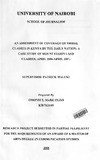| dc.description.abstract | Conflict management and peace building in Kenya faces major challenges in both national and regional fronts. Consequently, the National Steering Committee on Peace Building and Conflict Management (NSCPBCM) recently developed a draft policy framework on conflict management.
The need for a policy arose from the fact that strategic co-ordination among key actors has been lacking in conflict management and peace building. In such initiatives, the role of the media in conflict situation has often come under sharp focus. Media institutions have been singled out as critical players in the entire equation. The media is regarded by itself and those who consume it as a powerful tool for effecting and speeding up processes of social change.
This research sought to critically examine some of the factors behind Kenya’s print media’s way of handling conflict stories, with respect to the Mt Elgon land and tribal clashes. The research specific objectives included investigating the manner in which stories on Mt Elgon tribal and land clashes were treated, the actual trends in conflict reporting, key conflict issues covered and subsequently determining how the media, as an intervention tool and an agent of change, impacts on communities’ social relations. This was necessary towards determining the actual causes of the skirmishes and the role the media played through coverage.
v
The research found out that the pattern of coverage depended only on assigned jobs of covering formal events. The journalists and correspondents showed greater innovation in initiating their own stories and features. The stories on Mt Elgon tribal and land clashes, however, were hardly carried on the front page. This implies that the coverage was less prominent and mainly episodic.
Coverage handwork of local journalists’ was constructive and informative. It was also established that the Provincial Administration and Government received by far most of the blame for either fueling or failing to control the clashes, followed by Internal Security ministry, politicians and private individual/family/groups, respectively.
The important finding of this study vvac that there was significant variation in the trend and pattern of conflict coverage. As data clearly shows, the Daily Nation missed some important events as it has relied more on its own staff for the Mt Elgon clashes stories who did not routinely cover the conflict as news, and did not have regular columns on the conflict. It is of prime importance that the mass media concentrates on efforts to create awareness about effects of such internal conflicts and their potentially multi faceted impacts on the society. The quality of conflict coverage as established in this study points to the need for enhanced technical training among Kenyan journalists. The training should empower them to not only specialise in fields such as conflict and conflict resolution, but also to handle complex stories more competently. That is, efforts to
i
improve the skills amid professional status of Kenyan journalists need intensification as this society becomes more complex and diversified. | en_US |

